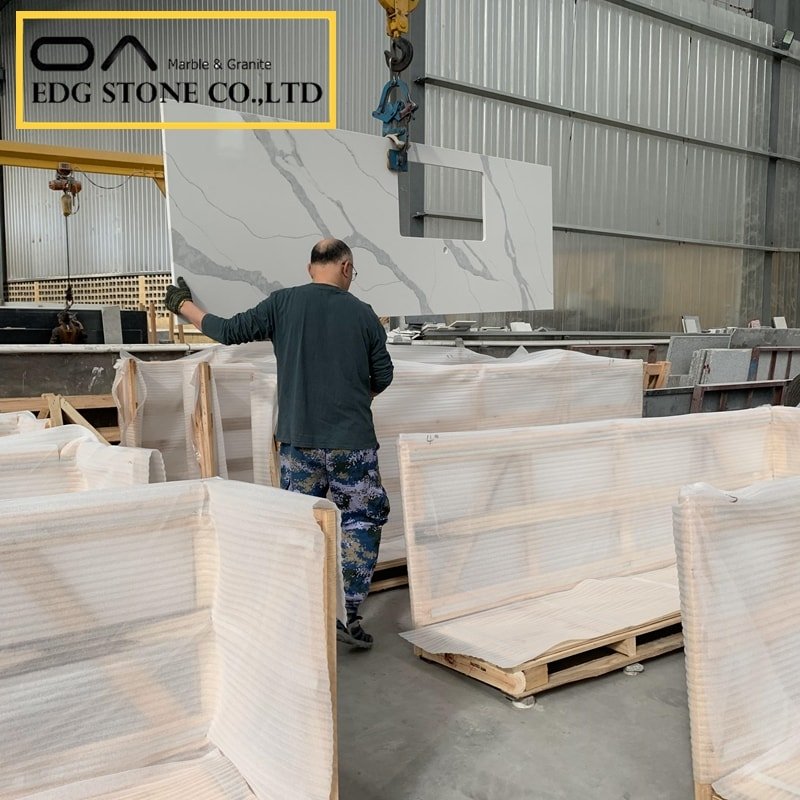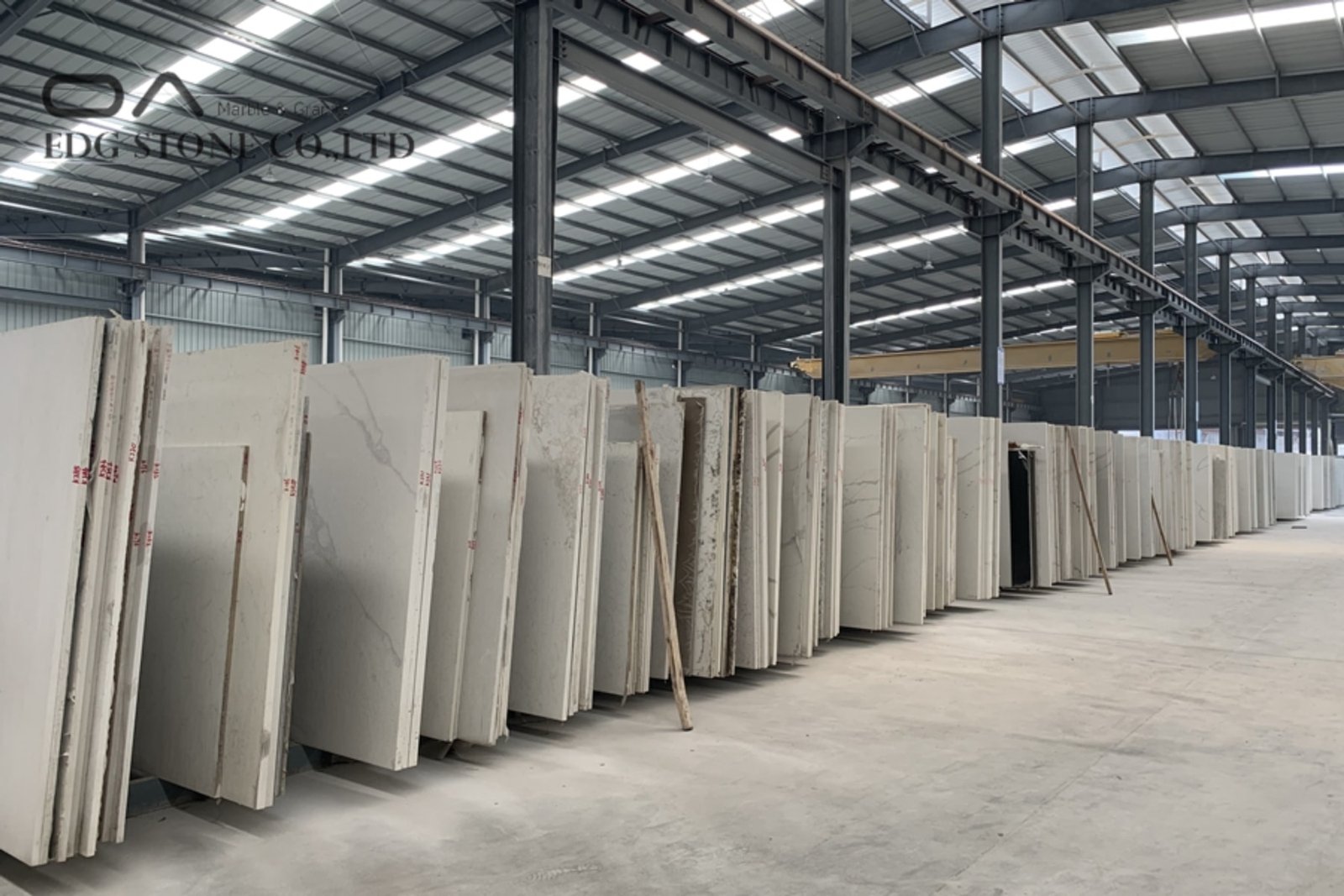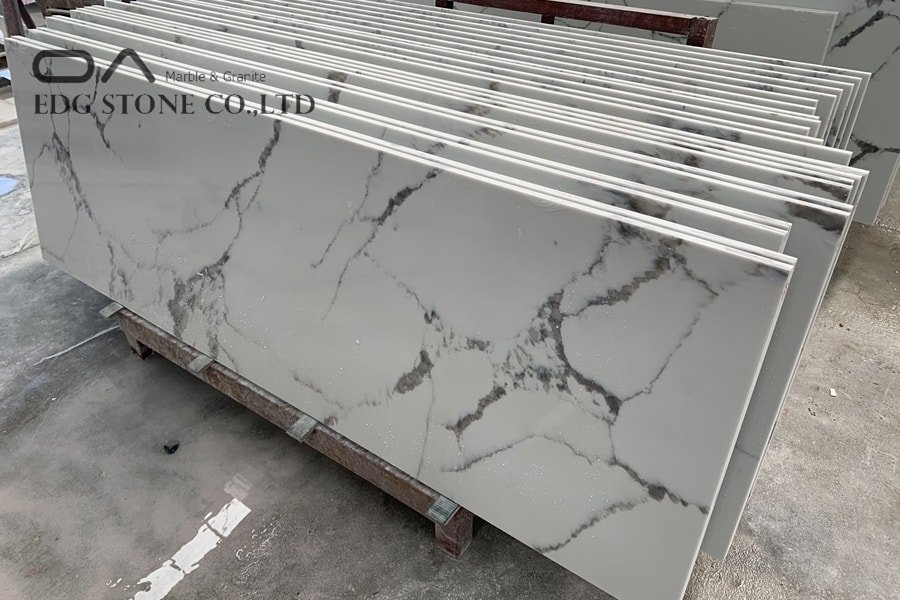1. Quartz stone production process:
Material mixing → fabric clamping → high-frequency shock pressure and vacuum exhaust with a large press → high temperature → grinding and polishing → cutting → the finished product
2. Finished Quartz Stone Processing Technology:
Quartz stone processing is an important part of ensuring the quality of countertops. No matter how good the quartz stone slab is, there will be quality problems if the strict quartz stone processing method is not followed. The processing requirements of quartz stone are in principle the same as the processing of natural stone, but it is the same as natural granite and granite. Operators who process quartz stone should preferably have experience in processing natural stone. Operators who have processing ordinary artificial stone but no experience in processing natural stone must in principle be trained before they can work.
Necessary processing tools: multifunctional marble cutting machine (cutting material, grinding, and chamfering), grinding machine (with special diamond grinding disc, resin grinding disc), cantilever water polishing machine, gong machine (with special gong head for quartz stone), Curve data, A-shaped clip, G-shaped clip, small blade, triangular glass fixture, wiring socket, etc.
Special glue: marble glue (white, transparent), special glue for quartz stone (prepared in a factory), special dry glue for quartz stone (prepared in a factory), curing agent.
Processing program:
Material selection and cutting → hole cutting corner → edge selection → bonding and thickening → trimming → gong edge → water grinding → waxing and polishing → inspection → packaging
Processing precautions: because the hardness of quartz stone is too high, its plasticity is not as strong as artificial stone, and the processing technology is also higher than that of artificial stone. The following are the matters that must be paid attention to when processing quartz stone:
① Connection: The connection of quartz stone generally adopts 45-degree splicing. When making a flat connection, the connecting surface must be straightened with a straight knife and gong. The connection can be done seamlessly. In addition, the color of the glue must be tested before the connection, and the large connection can be performed after the color is OK. Use a small blade to remove the remaining glue at the joint after gelling but before it is hard. When the glue is completely hardened, polish it again. The polishing range should not be expanded. After the quartz stone is connected, there will usually be traces like lines at the splicing, but it is not easy to see if you don’t look carefully, and it does not affect the appearance.
② Hole opening: When opening the furnace hole, there must be a backing plate at the bottom of the quartz stone plate, which cannot be completely suspended, and the bearing force must be uniform to prevent cracking during the hole opening process due to uneven force. Before opening the hole, first, reinforce the bottom four sides and the middle of the quartz stone, and then drill holes at the four corners of the furnace hole (the drill bit for drilling must be a high-hardness diamond drill bit, which is available in Yunfu’s stone processing tool supply store), and then use a wire cutting machine slowly And evenly cut into squares. When cutting, the plate cannot be cut through at one time. It should be cut in two steps. The first step is to cut 1/3 of the thickness of the plate, and the second step is to cut the plate through to prevent the plate from cracking. After the furnace hole is cut into a square shape, use an angle grinder to grind the four corners of the furnace hole into a circular arc angle, the radius of the arc is not less than R10mm, the back of the four corners of the furnace hole is thickened with a small plate of about 120×120mm, and then the angle grinder is ground into the corresponding The four sides are thickened with quartz stone plates with a width of more than 30mm. In addition, the distance between the edge of the furnace hole and the rear water retaining edge is not less than 70mm.
③Grinding and chamfering: use hard diamond water polishing pads, first 50#, then 150#, then 300#; when polishing, start with 500# water polishing pads, and then use 800#, 1000#, 1500#, 2000 in turn for polishing. Note that the diamond water-grinding disc must be hard, and it must be emphasized with the supplier. The size of the polishing pad is 3 inches or 4 inches, which can be determined according to the needs of users.
④Use of glue: The glue must be fully stirred before use. The glue curing agent is the same as an ordinary artificial stone curing agent, and the relationship between its addition and temperature is as follows:
⑴ When the temperature is below 10℃, the amount of curing agent added is 1.5-2% of the glue;
⑵ When the temperature is between 10°C and 20°C, the amount of curing agent added is 1% of the glue;
⑶When the temperature is 20℃–30℃, the amount of curing agent added is 0.5-0.8% of the glue;
⑷When the temperature is above 30℃, the amount of curing agent added is 0.5% of the glue.









